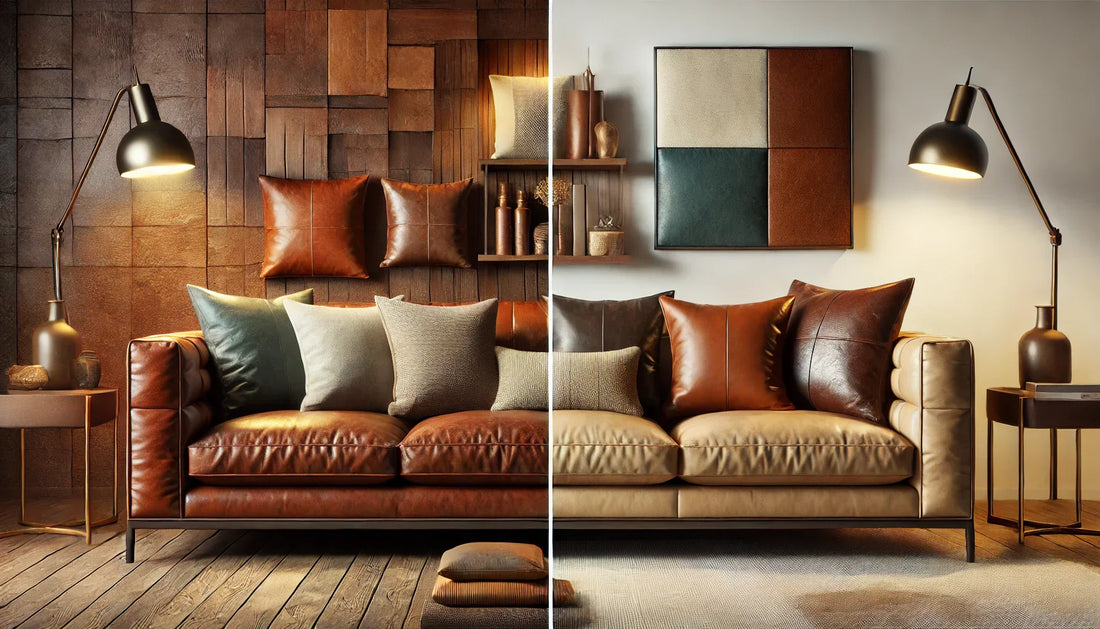
Leather vs Faux Leather Cushions: Which is Right for You?
Share
Leather cushions exude elegance and timeless appeal. But with the rise of faux leather alternatives, choosing between the two can be challenging. Whether you prioritize durability, aesthetics, or budget, understanding the pros and cons of each option is key to making an informed decision. Let’s dive deep into the leather vs faux leather cushions debate to help you pick the best fit for your space!
Why Your Choice of Cushion Material Matters
Your choice of cushion material impacts more than just looks. It affects durability, comfort, maintenance, and even sustainability. Leather cushions have long been associated with luxury and longevity, while faux leather provides a cost-effective, vegan-friendly alternative. But how do they truly compare? Let's break it down.
Key Differences Between Leather and Faux Leather Cushions
1. Material Composition
Leather Cushions
-
Made from animal hides, typically cowhide
-
Tanned and treated to enhance durability and appearance
-
Develops a patina over time, enhancing character
Faux Leather Cushions
-
Made from synthetic materials such as polyurethane (PU) or polyvinyl chloride (PVC)
-
Designed to mimic the look and feel of real leather
-
Available in a variety of textures and colors
2. Durability and Longevity
Leather cushions are known for their exceptional durability. They can withstand wear and tear for decades with proper care, developing a unique patina that enhances their beauty. On the other hand, faux leather cushions are less durable, prone to cracking and peeling over time, especially in high-use areas.
Leather Cushion Durability Pros:
-
Long-lasting (10-20+ years)
-
Resistant to tears and punctures
-
Ages beautifully
Faux Leather Durability Pros:
-
Resistant to stains and water
-
Low maintenance
-
Consistent appearance
3. Comfort and Feel
Leather cushions offer a natural, breathable feel that adapts to body temperature, making them comfortable in both warm and cool climates. Faux leather, however, can feel synthetic and may not offer the same level of breathability, leading to discomfort over time.
Leather Cushion Feel:
-
Softens and molds with use
-
Breathable and comfortable
-
Luxurious texture
Faux Leather Cushion Feel:
-
Often firmer and less pliable
-
Can feel sticky in hot weather
-
Uniform texture
4. Aesthetic Appeal
When it comes to visual appeal, leather cushions have a rich, luxurious look that improves over time. Faux leather, while designed to replicate real leather, can sometimes appear artificial under close inspection.
Leather Cushion Aesthetic Pros:
-
Unique grain and texture
-
Natural imperfections add character
-
Ages gracefully
Faux Leather Aesthetic Pros:
-
Available in a wider range of colors and styles
-
Consistent look with no imperfections
5. Cost Considerations
Budget plays a significant role in deciding between leather and faux leather cushions. Genuine leather cushions come with a higher price tag due to their durability and quality. Faux leather, however, offers a budget-friendly alternative that still delivers a stylish look.
Leather Cushion Cost:
-
Higher initial investment
-
Long-term value due to durability
Faux Leather Cushion Cost:
-
Affordable upfront cost
-
Needs replacement sooner
6. Maintenance and Care
Leather requires regular conditioning to prevent drying and cracking. Faux leather, on the other hand, is easier to clean and maintain, requiring only occasional wiping with a damp cloth.
Leather Cushion Maintenance:
-
Needs periodic conditioning
-
Avoid direct sunlight
Faux Leather Cushion Maintenance:
-
Wipe clean with mild soap and water
-
No special treatments required
7. Sustainability and Ethical Considerations
Sustainability is a growing concern in home decor choices. Leather production has environmental implications, including water consumption and chemical treatments. However, it's a natural material that biodegrades over time. Faux leather, made from plastics, poses environmental concerns due to its synthetic composition but appeals to those seeking cruelty-free alternatives.
Leather Cushion Sustainability:
-
Biodegradable
-
Ethically sourced options available
Faux Leather Cushion Sustainability:
-
Vegan-friendly
-
Lower carbon footprint in production
Choosing the Right Option for Your Needs
When deciding between leather vs faux leather cushions, consider these key factors:
-
For Luxury and Longevity: Choose leather if you're looking for a long-term investment.
-
For Budget-Friendly and Vegan Options: Faux leather is the way to go.
-
For High-Traffic Areas: Leather offers better durability.
-
For Low-Maintenance Needs: Faux leather is easier to care for.
Conclusion
Both leather and faux leather cushions have their advantages. Leather provides unmatched durability, comfort, and a timeless aesthetic, while faux leather offers affordability, versatility, and ethical benefits. Understanding your priorities—whether it's budget, maintenance, or style—will help you make the best choice for your home or office.
